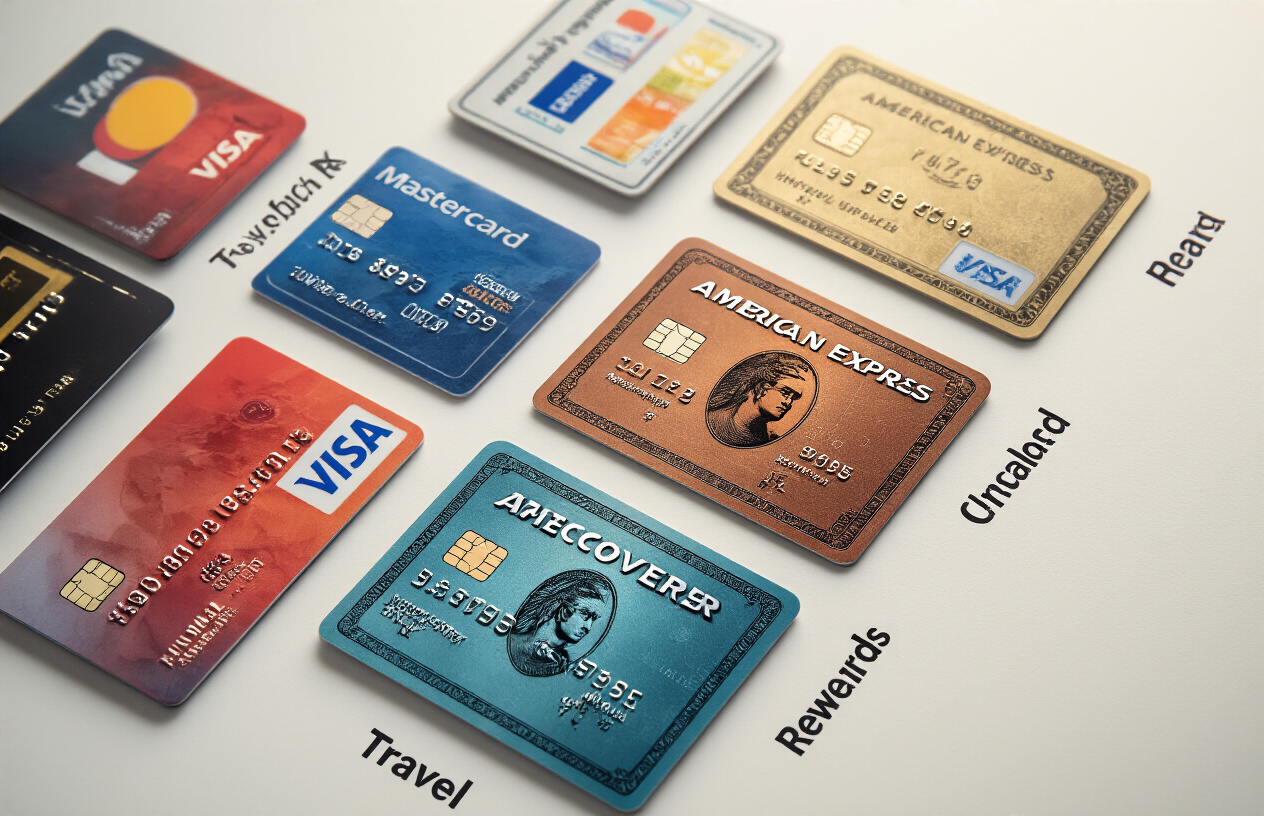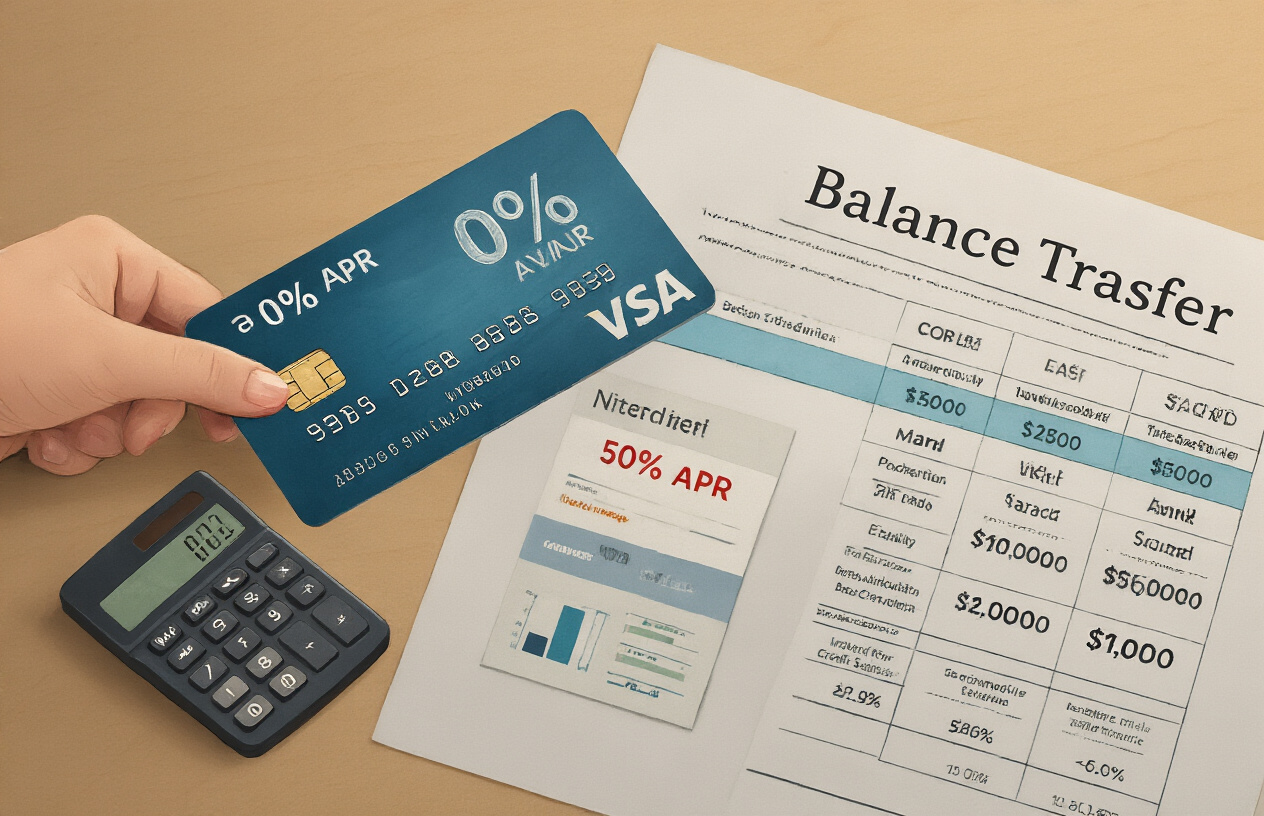Ever stared at your wallet, overwhelmed by the sheer number of credit card offers flooding your mailbox? You’re not alone. Americans carry an average of four credit cards each, yet most have no idea if they’re actually using the right ones.
Let me save you hours of research. I’ve analyzed hundreds of credit cards in the U.S. market to identify which ones actually deliver value beyond the flashy marketing.
Whether you’re chasing travel rewards, need to build credit, or want maximum cash back, this definitive ranking of top 10 credit cards in the U.S. cuts through the noise.
But here’s what you won’t expect: the card that topped our list isn’t from any of the “big banks” you’re thinking of right now.
table of contents
- 1 Understanding Credit Card Types
- 2 Best Cards for Cash Back Rewards
- 3 Premium Travel Credit Cards
- 4 Best Low APR and Balance Transfer Options
- 5 Credit Cards for Building or Rebuilding Credit
- 6 No Annual Fee Champions
- 7 Business Credit Card Powerhouses
- 8 Unique Cardholder Benefits Worth Considering
- 9 How to Choose the Right Card for Your Lifestyle
- 10 Application Tips and Approval Strategies
Understanding Credit Card Types

A. Rewards vs. Cash Back vs. Travel Cards
Credit cards aren’t one-size-fits-all, and picking the wrong type can leave money on the table.
Rewards Cards turn your everyday spending into points. Buy groceries, get points. Fill up your gas tank, get points. These points typically convert to gift cards, merchandise, or statement credits. The conversion rate? Usually around 1 cent per point, but it varies wildly between issuers.
Cash Back Cards cut through the complexity. No need to figure out redemption portals or point values—you get cold, hard cash (well, statement credits or direct deposits). Most offer 1-2% back on everything, while others bump specific categories to 5% or more.
Travel Cards shine if you’re a frequent flyer. The points often transfer to airline and hotel partners where they can be worth 2-3 cents each—far more than their cash equivalent. Plus, they pack perks like airport lounge access, free checked bags, and no foreign transaction fees.
Here’s a quick comparison:
| Card Type | Best For | Typical Return | Downsides |
|---|---|---|---|
| Rewards | Flexibility | 1-1.5% | Complex redemptions |
| Cash Back | Simplicity | 1-2% | Limited high-value options |
| Travel | Frequent travelers | 1.5-3%+ | Annual fees; useless if you don’t travel |
B. Low Interest vs. Balance Transfer Options
Got debt? The right card can save you thousands.
Low Interest Cards typically offer ongoing APRs between 10-15%—way below the national average of 20%+. Some even feature 0% intro periods on purchases for 12-18 months. Perfect if you need to make a big purchase and pay it off gradually.
Balance Transfer Cards are debt elimination machines. They let you move balances from high-interest cards to a new one with 0% interest for a limited time—usually 15-21 months. The catch? Transfer fees of 3-5% upfront.
The math isn’t complicated. If you’re carrying $5,000 at 22% APR, you’re burning $1,100 in interest annually. A balance transfer with a 3% fee ($150) that gives you 18 months at 0%? You’re ahead by $950.
C. Secured vs. Unsecured Cards
Unsecured Cards are what most people think of as “normal” credit cards. The issuer extends you credit based on your income and credit history—no collateral required. Higher scores unlock better terms, lower interest rates, and premium rewards.
Secured Cards require a security deposit that typically equals your credit limit. Put down $500, get a $500 limit. They’re designed for people with damaged credit or no credit history at all. The approval odds are dramatically higher since the issuer faces virtually no risk.
Many secured cards “graduate” to unsecured status after 6-12 months of responsible use, returning your deposit. This makes them perfect stepping stones to better credit products.
D. Business vs. Personal Cards
Personal Cards are designed for everyday consumers. They’re regulated by the CARD Act, which provides important protections like advance notice of rate increases and limits on penalty fees.
Business Cards offer perks tailored to company spending—higher limits, expense management tools, and rewards in business-centric categories like office supplies and internet services. Most don’t report to your personal credit unless you default, keeping your utilization ratio low.
Contrary to popular belief, you don’t need a formal business to qualify for a business card. Freelancers, side-hustlers, and sole proprietors can apply using their Social Security Number.
Best Cards for Cash Back Rewards

Highest Flat-Rate Cash Back Cards
Cash back cards without complicated rules? Yes, please! Flat-rate cash back cards are the simplest way to earn rewards on everything you buy.
The Citi Double Cash Card stands out with an effective 2% return on every purchase (1% when you buy, 1% when you pay). No categories to track, no quarterly sign-ups, just straightforward rewards that add up fast.
Wells Fargo Active Cash is another standout, offering a clean 2% cash rewards on purchases with no annual fee. It even throws in a sweet welcome bonus after meeting a minimum spend requirement within the first few months.
For those who bank with Capital One, the Quicksilver Cash Rewards delivers a solid 1.5% cash back on all purchases. While not the highest rate, its simplicity and zero foreign transaction fees make it perfect for travelers.
Rotating Category Champions
Want bigger cash back percentages? Rotating category cards might be your jam.
The Chase Freedom Flex leads the pack with 5% cash back in quarterly rotating categories (up to $1,500 in combined purchases). Think gas stations one quarter, groceries the next. The catch? You need to activate these categories each quarter, but the payoff is worth it.
Discover it Cash Back matches this 5% rotating category structure and adds a unique first-year bonus: Discover matches ALL the cash back you’ve earned at the end of your first year. Talk about doubling your money!
The cool thing about these cards? They also offer steady rewards in permanent categories. The Freedom Flex, for example, gives 3% on dining and drugstore purchases year-round.
Tiered Category Reward Options
If you spend heavily in specific areas all year, tiered reward cards deliver consistent value where you spend most.
The Blue Cash Preferred from American Express is the grocery champion, offering a massive 6% cash back at U.S. supermarkets (up to $6,000 per year, then 1%). It also gives 6% on select streaming services and 3% on transit and gas stations.
For foodies, the Capital One SavorOne Cash Rewards can’t be beat with 3% cash back on dining, entertainment, popular streaming services, and at grocery stores. No spending caps here!
The Bank of America Customized Cash Rewards lets you choose your own 3% category from options like online shopping, dining, travel, or gas. You also get 2% at grocery stores and wholesale clubs (up to $2,500 in combined 3% and 2% category purchases quarterly).
These tiered cards typically carry slightly higher annual fees, but run the numbers—heavy spenders in bonus categories often come out way ahead, even after fees.
Premium Travel Credit Cards

Airline-Specific Cards and Their Benefits
Ever notice how some people always seem to fly first class? They’re not necessarily richer than you—they’ve just mastered airline credit cards.
The Chase United Explorer Card gives you priority boarding, free checked bags, and 2X miles on United purchases. But here’s the real gem: the sign-up bonus often hits 60,000 miles—enough for a round-trip ticket to Europe. Not bad for a $95 annual fee (waived the first year).
Delta loyalists swear by the American Express Delta SkyMiles Platinum. For $250 annually, you’re getting a companion certificate each year (basically a buy-one-get-one ticket), 3X miles on Delta purchases, and fast-track to Medallion status through the MQD waiver.
Citi’s AAdvantage Platinum Select is American Airlines’ answer, offering similar perks: free bags, preferred boarding, and discounted in-flight purchases. But its real strength? The amazing redemption options through OneWorld partners like Qatar Airways and Japan Airlines.
Hotel Loyalty Card Programs
Hotel credit cards turn ordinary stays into mini-vacations.
The Marriott Bonvoy Brilliant American Express Card isn’t cheap at $450 annually, but you immediately get $300 in statement credits for Marriott purchases, automatic Gold Elite status, and a free night award (worth up to 50,000 points) every year. Do the math—if you stay at Marriotts even occasionally, you’re coming out ahead.
Hilton Honors American Express Surpass Card hits a sweet spot with a more manageable $95 annual fee. You’ll earn 12X points at Hilton properties, get complimentary Gold status (hello, free breakfast!), and 10 free Priority Pass lounge visits yearly.
The World of Hyatt Credit Card might be the sleeper hit among hotel cards. Hyatt’s smaller footprint is offset by their incredible value per point—often 2 cents each compared to Marriott’s 0.8 cents. The annual free night certificate easily offsets the $95 fee, and the path to elite status through card spending is more attainable than competitors.
General Travel Cards with Flexible Point Systems
Want maximum flexibility? These cards don’t tie you down.
The Chase Sapphire Reserve changed the premium card game forever. For $550 annually, you get $300 in travel credits, 3X points on travel and dining worldwide, and the ability to transfer points to partners like United, Hyatt, and Singapore Airlines. The 50% bonus when redeeming through Chase’s portal means your points are worth 1.5 cents each.
Capital One Venture X gives you 10X miles on hotels and rental cars booked through Capital One Travel, unlimited access to Capital One Lounges, and a yearly 10,000-mile anniversary bonus—all for $395. Plus, you can transfer miles to 15+ travel partners or use them to erase travel purchases at 1 cent per mile.
Airport Lounge Access and Premium Travel Perks
The Platinum Card from American Express is the undisputed lounge king. You’re getting access to Centurion Lounges, Delta SkyClubs (when flying Delta), Priority Pass lounges, and more. Add in the $200 airline fee credit, $200 in Uber credits, $100 Saks Fifth Avenue credit, and hotel elite statuses, and the $695 fee starts making sense.
For international travelers, nothing beats the perks on the Chase Sapphire Reserve. Beyond lounge access, you’re getting trip delay reimbursement, lost luggage insurance, primary rental car coverage, and no foreign transaction fees. The emergency evacuation coverage (up to $100,000) alone is worth its weight in gold when traveling to remote destinations.
Best Low APR and Balance Transfer Options

0% Intro APR Cards for New Purchases
Got big expenses coming up? A 0% intro APR card is like having an interest-free loan for a limited time. Here’s the cream of the crop:
Chase Freedom Unlimited gives you 15 months of 0% APR on purchases, plus you’ll earn 1.5% cash back on everything. That new refrigerator doesn’t look so expensive now, does it?
Citi Double Cash offers 18 months of 0% interest and rewards you twice – 1% when you buy and 1% when you pay. That’s breathing room AND money back in your pocket.
Discover it Cash Back comes with 14 months at 0% APR and matches all the cash back you earn during your first year. If you earn $300 in cash back, they’ll make it $600. Pretty sweet deal.
Longest 0% Balance Transfer Windows
Buried under credit card debt? These cards give you the longest runway to pay it off interest-free:
Citi Simplicity is the heavyweight champion with a whopping 21 months of 0% interest on balance transfers. No late fees, no penalty rates, no annual fee. Just breathing room.
U.S. Bank Visa Platinum offers 20 months of 0% APR on both balance transfers and purchases. The transfer fee is 3%, but that’s peanuts compared to what you’d pay in interest otherwise.
Wells Fargo Reflect provides up to 21 months of 0% APR if you make all your minimum payments on time. That’s almost two years to climb out of debt!
| Card | 0% APR Period | Transfer Fee | Notable Perks |
|---|---|---|---|
| Citi Simplicity | 21 months | 5% | No late fees |
| U.S. Bank Visa Platinum | 20 months | 3% | Cell phone protection |
| Wells Fargo Reflect | Up to 21 months | 3% | 3 months extension with on-time payments |
Cards with Low Ongoing Interest Rates
Not everyone can pay off their balance during a promo period. These cards keep the interest pain to a minimum long-term:
PenFed Promise Visa offers rates as low as 8.99% APR (variable), depending on your credit score. No balance transfer fees, no annual fee, no foreign transaction fees. It’s almost too good to be true.
Simmons Bank Visa starts at a rock-bottom 8.25% variable APR for those with excellent credit. It’s not flashy – no rewards program here – but the savings on interest makes up for it.
Lake Michigan Credit Union Prime Platinum boasts rates as low as 6.25% above prime rate. You’ll need to join the credit union, but the consistently low rates make it worth jumping through that hoop.
Think about this: on a $5,000 balance, the difference between a 24% APR and a 9% APR is about $750 a year in interest. That’s a plane ticket to somewhere nice or a few months of groceries!
Credit Cards for Building or Rebuilding Credit

A. Secured Cards with Upgrade Paths
Ever been stuck in credit score limbo? Secured cards are your ladder out. Unlike typical credit cards, these require a security deposit that usually equals your credit limit. But don’t worry—that deposit isn’t gone forever.
The real magic happens with upgrade paths. Some issuers review your account after 6-12 months of responsible use and may return your deposit while converting your account to an unsecured card. No new application, no credit check, just a seamless transition.
Take the Discover it® Secured Credit Card. Put down $200, get a $200 limit, and earn cash back while you’re at it. After 7 months, Discover automatically reviews your account for a possible upgrade. Pretty sweet deal.
Capital One’s Quicksilver Secured also deserves attention. With automatic consideration for a higher credit line in as little as 6 months, your rebuilding journey gets a turbo boost.
B. Student Credit Card Options
College life is expensive enough without credit card fees weighing you down. Student cards are specifically designed for those with limited credit history but have a .edu email address.
The Discover it® Student Cash Back card is basically the cool kid on campus. You’ll get 5% cash back in rotating categories, a good grades reward ($20 statement credit for each school year you maintain a 3.0 GPA), and—get this—Discover matches all the cash back you earn during your first year.
Bank of America’s Cash Rewards for Students deserves honorable mention too. It lets you choose which category earns 3% cash back each month. Groceries during finals week? Gas for that spring break road trip? You decide.
The key difference between student cards and secured cards? No deposit required. Just proof that you’re enrolled in school.
C. Cards with Credit Monitoring Tools
What good is building credit if you can’t track your progress? Modern rebuilding cards come with powerful monitoring tools that turn credit management from a mystery into a science.
Capital One’s CreditWise gives you unlimited access to your credit score, plus alerts when anything suspicious pops up on your report. You don’t even need to be a cardholder to use it, but their rebuilding cards include access.
Discover’s Credit Scorecard similarly offers your FICO® Score for free, updated monthly. They’ll also break down exactly what’s impacting your score.
Self’s Secured Visa® takes a different approach. It combines a credit-builder loan with a secured card, helping you establish payment history before transitioning to a traditional card.
The best part? These tools transform an intimidating process into something trackable and achievable. You’re not just blindly making payments—you’re watching your score climb with each on-time payment.
No Annual Fee Champions

Best Rewards with No Annual Fee
Who says you need to pay annual fees to rack up serious rewards? Not these cards. They’re the all-stars that let you earn while keeping your wallet happy.
The Citi Double Cash Card is practically throwing money at you with 2% cash back on everything (1% when you buy, 1% when you pay). No categories to track, no quarterly sign-ups – just straight-up rewards for existing.
Then there’s the Discover it Cash Back. This little gem gives you 5% back on rotating categories (like gas stations, grocery stores, and Amazon) on up to $1,500 each quarter. Plus, they DOUBLE all the cash back you earn in your first year. Yes, double. That’s potentially 10% back if you play your cards right.
The Capital One SavorOne deserves major props too. It dishes out 3% cash back on dining, entertainment, popular streaming services, and grocery stores. For foodies who’d rather eat out than cook, this one’s your new best friend.
Travel Benefits Without the Cost
Think travel perks are only for folks willing to shell out $500+ annual fees? Think again.
The Wells Fargo Autograph Card is quietly crushing it with 3x points on restaurants, travel, gas stations, transit, popular streaming services, and phone plans. Plus, you get cell phone protection just for paying your phone bill with the card. Oh, and zero foreign transaction fees – because nobody wants to do that math while vacationing.
Bank of America Travel Rewards keeps things stupidly simple: 1.5 points per dollar on everything, then redeem those points to wipe out travel purchases. No blackout dates, no airline loyalty required. Just book your trip however you want, then erase it.
Capital One VentureOne might be the “lite” version of its famous sibling, but it still packs 1.25x miles on every purchase and gives you transfer options to actual airline partners – something most no-fee cards wouldn’t dream of offering.
Best First-Timer Cards
New to credit? These cards won’t judge.
The Discover it Student Cash Back is basically the cool teacher of credit cards. It offers the same 5% rotating categories as the regular version, but it’s easier to get approved for with limited credit history. Plus, they give you a $20 statement credit each year you maintain a 3.0 GPA. Getting paid to study? Yes please.
Capital One Platinum is the no-nonsense option. No rewards (sad face), but it’s widely available to credit newcomers and comes with automatic credit line reviews after 6 months. Start small, grow fast.
The Chase Freedom Student card deserves a spot in your wallet with its flat 1% cash back, $20 annual “good standing” rewards for the first 5 years, and the chance to graduate to better Chase cards once you’ve proven yourself.
Business Credit Card Powerhouses

Best for Small Business Expenses
Running a business means keeping track of every dollar spent. The right credit card doesn’t just pay for stuff—it works for your business around the clock.
The Chase Ink Business Preferred stands out with 3x points on travel, shipping, internet, cable, phone services, and advertising purchases (up to $150,000 annually). With a reasonable $95 annual fee, it delivers serious value for most small business owners.
Need something with no annual fee? The American Express Blue Business Cash card gives you 2% cash back on all purchases (up to $50,000 per calendar year). Simple, straightforward, and perfect for businesses with predictable monthly expenses.
For those just starting out, the Capital One Spark Classic for Business offers 1% cash back on all purchases with no annual fee—and it’s accessible to business owners with credit scores as low as 580. Building credit while earning rewards? Yes, please.
Cards with Robust Expense Management Tools
The real magic of business credit cards isn’t just in the rewards—it’s in the tools that save you hours of bookkeeping headaches.
American Express Business Gold knocks it out of the park with expense management. Their app automatically categorizes expenses, allows receipt matching via photos, and generates year-end summaries that your accountant will actually thank you for. The $295 annual fee pays for itself in time saved alone.
The Brex Card takes expense management to another level with built-in integrations for QuickBooks, Xero, and NetSuite. Plus, their AI-powered receipt matcher makes expense reports practically write themselves.
Divvy combines a business credit card with comprehensive software that helps control spending before it happens. Set budgets for teams or projects, and watch in real-time as expenses roll in. No more end-of-month surprises.
High Credit Limit Options for Growing Businesses
When your business is scaling fast, the last thing you need is a declined card at a crucial moment.
The Chase Ink Business Unlimited offers impressive initial credit limits and regular automatic increases based on spending patterns and payment history. Many businesses report limits exceeding $50,000 within the first year.
For established businesses, the American Express Business Platinum often comes with sky-high limits. While Amex doesn’t publish their exact figures, users regularly report limits well into six figures.
Employee Card Features
Your team needs spending power, but you need control. These cards deliver both.
The Capital One Spark Miles for Business offers free employee cards with customizable spending limits for each user. The detailed spending reports break down expenses by employee, making accountability crystal clear.
Amex Business Green Card goes beyond basic employee cards with purchase alerts, spending limits that adjust by time period (daily, weekly, monthly), and the ability to freeze individual cards instantly from your phone.
Unique Cardholder Benefits Worth Considering

Purchase Protection and Extended Warranties
Credit cards aren’t just for spending—they can actually save you when things go wrong. Most people have no idea that the premium card in their wallet might be their ticket to replacing that brand-new laptop they just spilled coffee on.
Here’s the deal: Purchase protection covers items you buy against damage or theft, usually for 90-120 days. So when your new phone slips out of your hand the day after you bought it? Your card might have your back.
Extended warranties are the other hidden gem. They typically add an extra year of coverage after the manufacturer’s warranty expires. That means when your TV mysteriously dies 13 months after purchase, you’re not out of luck.
The coverage limits vary wildly:
| Card Type | Purchase Protection | Extended Warranty |
|---|---|---|
| Premium | Up to $10,000 per claim | +1-2 years |
| Mid-tier | Up to $1,000 per claim | +1 year |
| Basic | Limited or none | Limited or none |
The catch? You need to pay for the item entirely with your card and keep your receipts. Small price to pay for potentially saving hundreds or thousands of dollars.
Cell Phone Insurance Options
Your smartphone probably costs more than your first car, so why not protect it? Several cards now offer cell phone insurance when you pay your monthly phone bill with them.
The typical coverage runs between $600-$800 per claim with a $25-$50 deductible. Most cards allow 2-3 claims per year.
The Wells Fargo Active Cash and several Chase cards offer this perk, and it’s becoming more common across the industry. The best part? This coverage often includes things your carrier’s insurance might not, like mysterious disappearance (aka “I have no idea where my phone went”).
Just remember—this isn’t for cosmetic damage. That spider web crack that doesn’t affect functionality? You’re on your own.
Exclusive Event Access and Experiences
Money can’t buy happiness, but the right credit card can buy experiences that aren’t available to the general public.
Premium cards like Amex Platinum and Chase Sapphire Reserve offer cardholders first dibs on concert tickets, private dining experiences with celebrity chefs, and VIP sporting events. We’re talking front-row seats at sold-out shows or intimate cooking classes with Michelin-starred chefs.
Capital One’s entertainment access has exploded recently with their cardholder-only lounges at major venues and festivals. Citi’s Private Pass program gets you presale tickets to thousands of events annually.
The value here is impossible to quantify—how do you put a price on your kid’s face when you score impossible-to-get tickets to their favorite artist?
Your everyday expenses can become rewards with the right card. Many now offer monthly credits for Uber, Lyft, DoorDash, or Grubhub.
The American Express Gold Card provides $10 monthly dining credits that work with Grubhub and select restaurants. The Chase Sapphire Reserve gives cardholders $5-10 monthly DoorDash credits plus a complimentary DashPass subscription.
These seemingly small perks add up fast—$10 monthly is $120 annually that goes straight back into your pocket.
Streaming Service Credits
Streaming services have practically replaced cable, and your credit card can help foot the bill. Cards like the Blue Cash Preferred from American Express offer 6% cash back on select streaming services.
Others provide direct monthly credits—the Amex Platinum offers up to $20 monthly for services like Disney+, Hulu, ESPN+, Peacock, and more.
With the average household subscribing to 4+ streaming services, these credits can save $100-$240 annually. Not bad for just using the right card to pay your bills.
How to Choose the Right Card for Your Lifestyle

A. Spending Pattern Analysis
Picking the right credit card starts with knowing where your money goes. Pull up your last three months of bank statements and look for patterns.
Are you dropping serious cash at restaurants? Travel rewards cards might be your jam. Forever filling up your gas tank? Look at cards with higher cash back on fuel purchases. Basically, your spending habits should drive your card choice.
Most people fall into specific spending categories:
- Everyday spenders: Groceries, gas, utilities
- Travel enthusiasts: Flights, hotels, rental cars
- Business owners: Office supplies, client dinners, shipping
- Family-focused: Kids’ activities, big box stores, medical
Once you know your category, you can zero in on cards that reward that specific behavior. If you’re dropping $500 monthly at grocery stores, a card offering 6% back there means an extra $360 in your pocket annually.
B. Credit Score Considerations
Your credit score isn’t just a number – it’s the gatekeeper to the best cards on the market.
| Credit Score Range | Card Options |
|---|---|
| 750+ | Premium rewards, luxury travel perks |
| 670-749 | Good rewards cards, competitive APRs |
| 580-669 | Basic rewards, secured cards |
| Below 580 | Secured cards, credit builder products |
Got a score below 670? Don’t sweat it. Start with a secured card or a card specifically designed for credit building. Use it responsibly for 6-12 months, and watch your options expand.
Top-tier cards like the Chase Sapphire Reserve or Amex Platinum typically want to see scores above 740, while mid-tier options might be available with scores in the high 600s.
C. Annual Fee vs. Rewards Value Calculation
Annual fees freak people out. But here’s the thing – sometimes paying that fee makes perfect mathematical sense.
Take a $95 annual fee card that gives you 4% back on groceries versus a no-fee card offering 1%. If you spend $400 monthly on groceries:
- No-fee card: $48 yearly rewards
- $95 fee card: $192 yearly rewards – $95 fee = $97 net gain
The calculation is simple:
- Estimate your annual spending in each bonus category
- Calculate expected rewards based on percentage back
- Subtract annual fee
- Compare with other card options
Don’t forget about sign-up bonuses either. A $200 welcome bonus effectively wipes out a $95 annual fee for the first two years.
D. Complementary Card Strategies
Credit card ninjas don’t just carry one card – they strategically pair multiple cards to maximize every dollar spent.
The “card stack” approach works like this:
- Card #1: Highest rewards for your top spending category
- Card #2: Strong general spending rewards (1.5-2% on everything)
- Optional Card #3: Specialized for your secondary spending category
For example, pairing the Blue Cash Preferred (6% on groceries) with a 2% flat-rate card like the Citi Double Cash covers most bases.
Or try the “ecosystem approach” – staying within one bank’s family of cards to pool points. Chase’s trifecta (Freedom Flex, Freedom Unlimited, and Sapphire Preferred) lets you maximize points earning and then transfer everything to your Sapphire for higher-value redemptions.
Just don’t go overboard – each new application temporarily dings your credit score, and juggling too many payment dates can lead to missed payments.
Application Tips and Approval Strategies

A. Timing Your Application for Success
Ever wondered why some people get approved for credit cards while others don’t? Timing matters more than you think.
December is actually one of the worst months to apply for premium cards. Banks are swamped with holiday applications, and approval officers are juggling vacation schedules. Instead, aim for January through March when approval departments are fully staffed and looking to meet first-quarter goals.
Another pro tip? Apply early in the week and early in the month. Credit departments are freshest on Tuesdays and Wednesdays, not Friday afternoons when they’re racing to start their weekends.
And if you’ve recently applied for multiple cards, pump the brakes. Most issuers follow the 2/30 rule – meaning they’ll automatically reject you if you’ve already gotten two cards in the past 30 days.
B. Credit Score Thresholds for Top Cards
The cold hard truth? That shiny metal card you’re eyeing has a minimum credit score requirement, whether they advertise it or not.
Here’s what you’re really looking at for top cards:
| Card Type | Typical Minimum FICO | Ideal FICO |
|---|---|---|
| Premium Travel (Chase Sapphire Reserve) | 720+ | 760+ |
| Cash Back (Citi Double Cash) | 680+ | 720+ |
| Store Cards (Target RedCard) | 640+ | 680+ |
| Secured Cards | 580+ | 620+ |
Don’t waste a hard inquiry on a card that’s out of reach. If your score is below 700, focus on cards labeled “good credit” rather than “excellent credit” to maximize approval odds.
The secret most blogs won’t tell you? It’s not just about the number. A 750 with six recent inquiries looks riskier to issuers than a 720 with zero inquiries in the past year.
C. Pre-Qualification Tools to Avoid Hard Inquiries
Hard inquiries can ding your credit score by 5-10 points each time. That’s where pre-qualification tools become your best friend.
Almost every major issuer now offers these tools:
- American Express has their famous “Check for Pre-approved Offers” tool
- Capital One’s pre-approval is particularly accurate
- Chase’s “Just for You” section shows personalized offers with high approval odds
When using these tools, pay attention to the language. “Pre-qualified” means you meet initial criteria, while “Pre-approved” is stronger and indicates higher approval chances.
Don’t forget about credit card comparison marketplaces like CreditKarma and NerdWallet. They’ll match your profile against multiple cards simultaneously without affecting your score.
The smartest approach? Run a pre-qualification check, apply for only one card, wait for approval, then use that card responsibly for 3-6 months before applying for another. Your future credit score will thank you.

Choosing the right credit card can significantly impact your financial health and lifestyle. From cash back rewards that put money back in your pocket to premium travel perks that enhance your journeys, today’s credit card market offers something for everyone. Whether you’re looking to build credit, manage business expenses, or simply avoid annual fees, understanding the strengths of each card type helps you make an informed decision that aligns with your specific needs.
Remember that the best credit card is ultimately the one that fits your spending habits and financial goals. Take time to evaluate your priorities, from interest rates to rewards structures, before applying. With strategic selection and responsible use, these powerful financial tools can work for you rather than against you. Start by considering which of our top 10 recommendations matches your lifestyle, and take the first step toward smarter credit card ownership today.


